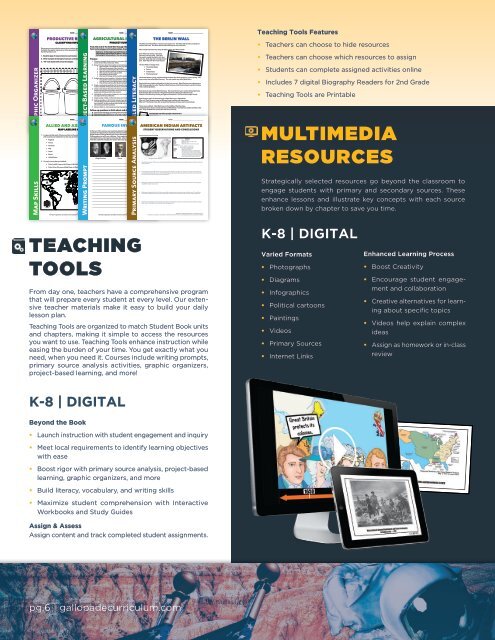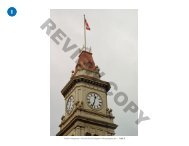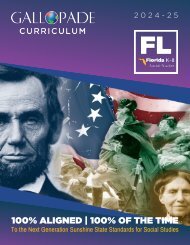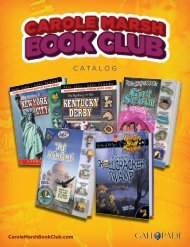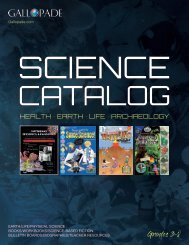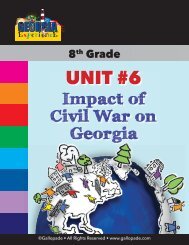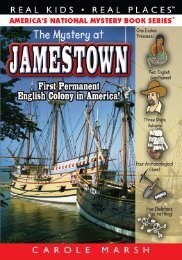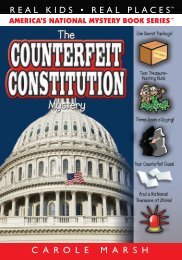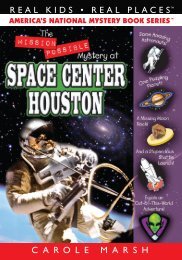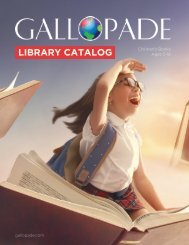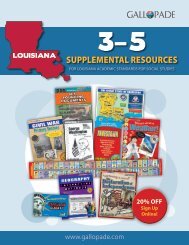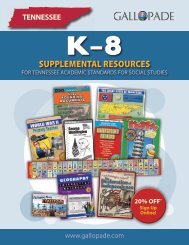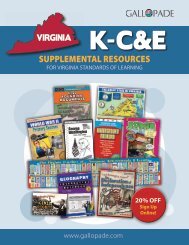Tennessee Curriculum Catalog
Grades K-8 Social Studies Curriculum Catalog.
Grades K-8 Social Studies Curriculum Catalog.
Create successful ePaper yourself
Turn your PDF publications into a flip-book with our unique Google optimized e-Paper software.
NAME: _____________________________________________<br />
NAME: _____________________________________________<br />
1. Choose a new agricultural invention or innovation that became popular in the South between the<br />
end of the Civil War and the early 1900s.<br />
2. Research to learn about the invention or innovation you selected, including:<br />
• Who invented or innovated the item you selected?<br />
• What was the purpose of the invention?<br />
• How was the process before the invention different than after the invention?<br />
• Was the invention relatively inexpensive or expensive?<br />
• Who was the invention popular with?<br />
• How did the invention work?<br />
• What part of farming did the invention impact?<br />
3. Analyze what you learn to explain: (Include positives and negative results.)<br />
• How did the invention impact farmers, including large plantation owners,<br />
small farm owners, and sharecroppers and tenant farmers.<br />
• How did the invention affect life and culture in the South?<br />
4. Create a mock patent application for the invention you selected.<br />
Include a detailed drawing and descriptions of how the invention works.<br />
5. Create a web diagram that shows the impact your invention had on various groups of<br />
Southern farmers and on Southern culture. Be sure to explain how the invention affected<br />
people who did the job before the invention.<br />
6. Individually, or with a partner, design your own invention that could have been useful in<br />
any region of the U.S. at that time.<br />
7. Create a poster, model, or other tool about your invention.<br />
8. Hold an exposition, or fair, for other classes at your school. Display your patent application<br />
and web diagram for the invention you researched, as well as whatever you made for your<br />
own invention. As other students walk through your exposition, explain the inventions you<br />
are showing and answer questions.<br />
9. Discuss, reflect on, and evaluate your learning experience.<br />
Î How did new technology use existing resources in the South?<br />
Î What was the role of the North in technology in the South?<br />
Î What were positive and negative results of this shift?<br />
Î What is an example today of a technological advancement that reduces the<br />
amount of labor needed to do a job? And, what are positive and negative<br />
NAME: _____________________________________________<br />
NAME: _____________________________________________<br />
To add this to your interactive workbook, cut along the outside dashed lines, and fold on the solid line.<br />
consequences of that result?<br />
Put glue on the BACK of the striped area, and glue it to the top of a page it relates to.<br />
Glue it so it is readable when flat, and you can fold it upwards to read the workbook page.<br />
NAME: _____________________________________________<br />
NAME: _____________________________________________<br />
©Gallopade • All Rights Reserved • www.gallopade.com<br />
©Gallopade • All Rights Reserved • www.gallopade.com<br />
©Gallopade • All Rights Reserved • www.gallopade.com<br />
Permission is granted to use Toolbox only with students for whom a current-year Experience Class Set Permission purchased. is granted to use Toolbox only with students for whom a current-year Experience Class Set Permission purchased. is granted to use Toolbox only with students for whom a current-year Experience Class Set is purchased.<br />
Drawing of a burial container found in an<br />
Indian burial mound on one of<br />
Georgia’s barrier islands<br />
Items<br />
Materials<br />
Cups<br />
Made Made from from shell shell<br />
Bowls<br />
Made Made from from turtle turtle shell, shell, clay, clay, or or shell shell<br />
Chisels<br />
Made from from rock rock<br />
Knives<br />
Made from from shell shell and and rocks; rocks: various various types types<br />
Agriculture tools<br />
• • Shovels - Made - Made from from large large shells shells<br />
• • Axes Axes - Made - Made from from chiseled chiseled rock rock<br />
Gorgets<br />
Very ornate; made of of shell shells<br />
Necklaces<br />
Made from small small shells shells<br />
Other<br />
Various weapons such such a rock-tipped as rock-tipped spears, spears, what<br />
appears what appears to be baskets to be or basket possibly or possibly traps, and traps, other<br />
broken and other pieces broken of pottery pieces made of pottery from clay made (some from<br />
pottery clay (some has ornate pottery designs has ornate sculpted designs into the sculpted clay).<br />
List of contents found Shell<br />
into<br />
necklaces<br />
the clay),<br />
in and and<br />
shell<br />
nearby broken<br />
necklaces<br />
shell the pieces;<br />
and broken<br />
burial copper<br />
shell<br />
container<br />
pieces; copper plated weapons and jewelry<br />
plated weapons and jewelry.<br />
1. Describe the container. What can you learn about the tribe and how they lived by examining the bones and other contents of a<br />
burial container?<br />
2. Archaeologists reported they found a “circular gorget made of shell.” A gorget is an ornament or pendant worn around the<br />
neck indicating the status of a person. What does finding a gorget tell you about the person buried in this mound? Does this<br />
give clues as to how the tribe may have been organized?<br />
3. What types of tools did the archaeologists find in the Indian mound? What do the tools tell you about their technology and<br />
capabilities? Explain your answer.<br />
4. What types of materials found in this Indian mound did the people use to make tools, cups, and other items? If you did not<br />
know where this tribe lived, what do the materials used to make tools tell you about the environment in which they lived?<br />
5. Explain why archaeologists, anthropologists, and historians utilize Indian mounds to reconstruct how early Indians in Georgia<br />
lived. Why is it important to know how the earliest Georgians lived?<br />
©Gallopade • All Rights Reserved • www.gallopade.com<br />
©Gallopade • All Rights Reserved • www.gallopade.com<br />
©Gallopade • All Rights Reserved • www.gallopade.com<br />
Permission is granted to use Toolbox only with students for whom a current-year Experience Class Set Permission purchased. is granted to use Toolbox only with students for whom a current-year Experience Class Set Permission purchased. is granted to use Toolbox only with students for whom a current-year Experience Class Set is purchased.<br />
Map Skills<br />
Graphic Organizer<br />
PRODUCTIVE RESOURCES AGRICULTURAL INVENTIONS THE BERLIN WALL<br />
CLASSIFYING INFORMATION<br />
PROJECT SUMMARY<br />
The Allies won World War II. Germany and Japan lost. The Allies told Germany it could not<br />
make a new army. The Allies did not want Germany to start a new war.<br />
From the end of the Civil War through the early-to-mid 1900s, new<br />
Entrepreneurs use productive resources to produce goods and provide services.<br />
farm technology and mechanization changed farming in<br />
Complete the graphic organizer by listing examples of all three types of productive resources<br />
Who the would South. make Germany obey the Allies’ rules? The Allies would!<br />
that entrepreneurs use.<br />
Summary: In this project, you will choose one agricultural technological<br />
advancement and analyze its effects. You will also invent your Four own Allies took charge. They split<br />
technological advancement. You may work individually or with a partner.<br />
1. Read the type of resource listed on each bucket.<br />
Germany into four parts. They split<br />
Germany’s capital city, Berlin, into four<br />
2. Write examples of that type of resource on the bucket. Process:<br />
parts too. Each Ally was in charge of one<br />
part. Each Ally sent its army to its part.<br />
3. “Fill” each bucket with at least 6 examples.<br />
The four Allies in charge were:<br />
• The United States<br />
• France<br />
put glue on the BACK of this striped section<br />
• Great Britain<br />
Project-Based Learning<br />
Natural Resources Human Resources Capital Resources<br />
Follow-up questions to think about and discuss:<br />
Leveled Literacy<br />
• The Soviet Union<br />
The United States, France, and Great Britain helped their three parts form a new country. The<br />
new country was called West Germany. The new capital was called West Berlin.<br />
People had many rights and freedoms in their new country. West Germany was a democracy.<br />
That means people can vote! People in West Germany could choose how to use their money.<br />
That is called capitalism.<br />
East Germany was not like West Germany. The Soviet Union was in control of East Germany.<br />
East Germany was Communist. The government had authority to make the rules.<br />
People in East Germany did not get rights and freedoms. The Soviet Union kept control.<br />
East Germans were not allowed to go to West Germany or West Berlin.<br />
Why not? East Germans were not allowed to go to places with democracy.<br />
Why not? The Soviet Union did not want East Germans to leave and not come back.<br />
There was a problem: West Berlin was in the middle of East Germany.<br />
The Soviet Union built a very tall wall around West Berlin. East German soldiers worked at the<br />
wall. They decided who could enter and who could exit.<br />
How did the wall affect people in East Berlin?<br />
How did the wall affect people in West Berlin?<br />
R<br />
•<br />
ALLIED AND AXIS POWERS FAMOUS INVENTORAMERICAN INDIAN ARTIFACTS<br />
MAP LABELING ACTIVITY<br />
STUDENT OBSERVATIONS AND CONCLUSIONS<br />
At the turn of the century, new inventions played a huge role. Imagine that you are a journalist<br />
and have the opportunity to interview a famous inventor from this era. Choose either the<br />
1. Locate and label each of these countries on the world map.<br />
Wright brothers, George Washington Carver, Alexander Graham Bell, or Thomas Edison.<br />
(The countries are labeled A-G on the map, but the order is mixed up.)<br />
Write questions to ask in your interview. Your questions should focus on their inventions,<br />
accomplishments, and impact on American life. After completing your questions, write an<br />
• England<br />
interview script that includes their answer after each question.<br />
• France<br />
• Germany<br />
• Italy<br />
• Japan<br />
• Russia<br />
• United States<br />
2. For each country that you labeled:<br />
• Color it red if it was an Axis Power in World War II.<br />
• Color it blue if it was an Allied Power in World War II.<br />
B<br />
C<br />
D<br />
A<br />
E<br />
WRITING PROMPT<br />
Primary Source Analysis<br />
Wright Brothers Carver Bell Edison<br />
__________________________________________________________________________________<br />
__________________________________________________________________________________<br />
__________________________________________________________________________________<br />
__________________________________________________________________________________<br />
__________________________________________________________________________________<br />
F<br />
__________________________________________________________________________________<br />
__________________________________________________________________________________<br />
__________________________________________________________________________________<br />
__________________________________________________________________________________<br />
G<br />
__________________________________________________________________________________<br />
__________________________________________________________________________________<br />
__________________________________________________________________________________<br />
__________________________________________________________________________________<br />
__________________________________________________________________________________<br />
__________________________________________________________________________________<br />
__________________________________________________________________________________<br />
Teaching Tools Features<br />
• Teachers can choose to hide resources<br />
• Teachers can choose which resources to assign<br />
• Students can complete assigned activities online<br />
• Includes 7 digital Biography Readers for 2nd Grade<br />
• Teaching Tools are Printable<br />
MULTIMEDIA<br />
RESOURCES<br />
Strategically selected resources go beyond the classroom to<br />
engage students with primary and secondary sources. These<br />
enhance lessons and illustrate key concepts with each source<br />
broken down by chapter to save you time.<br />
TEACHING<br />
TOOLS<br />
From day one, teachers have a comprehensive program<br />
that will prepare every student at every level. Our extensive<br />
teacher materials make it easy to build your daily<br />
lesson plan.<br />
Teaching Tools are organized to match Student Book units<br />
and chapters, making it simple to access the resources<br />
you want to use. Teaching Tools enhance instruction while<br />
easing the burden of your time. You get exactly what you<br />
need, when you need it. Courses include writing prompts,<br />
primary source analysis activities, graphic organizers,<br />
project-based learning, and more!<br />
K-8 | DIGITAL<br />
Beyond the Book<br />
• Launch instruction with student engagement and inquiry<br />
• Meet local requirements to identify learning objectives<br />
with ease<br />
• Boost rigor with primary source analysis, project-based<br />
learning, graphic organizers, and more<br />
• Build literacy, vocabulary, and writing skills<br />
• Maximize student comprehension with Interactive<br />
Workbooks and Study Guides<br />
Assign & Assess<br />
Assign content and track completed student assignments.<br />
K-8 | DIGITAL<br />
Varied Formats<br />
• Photographs<br />
• Diagrams<br />
• Infographics<br />
• Political cartoons<br />
• Paintings<br />
• Videos<br />
• Primary Sources<br />
• Internet Links<br />
Enhanced Learning Process<br />
• Boost Creativity<br />
• Encourage student engagement<br />
and collaboration<br />
• Creative alternatives for learning<br />
about specific topics<br />
• Videos help explain complex<br />
ideas<br />
• Assign as homework or in-class<br />
review<br />
pg.6 | gallopadecurriculum.com


